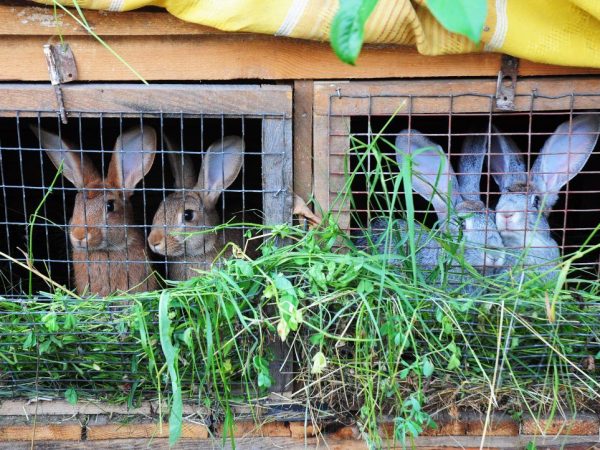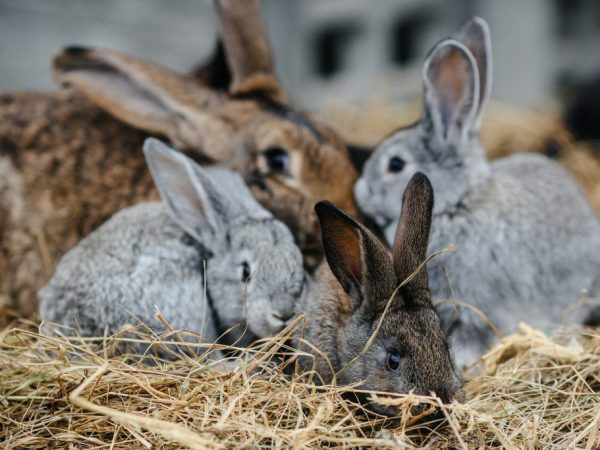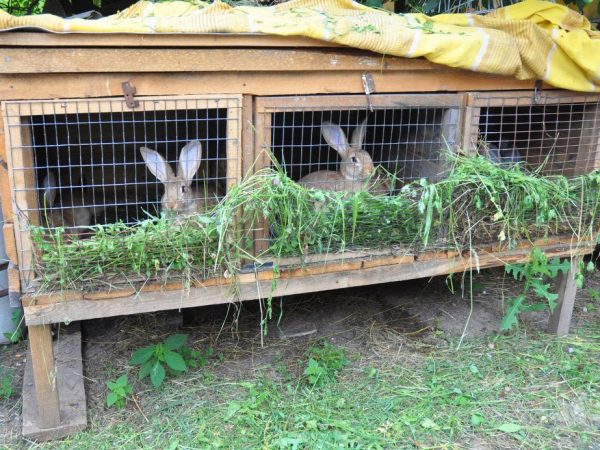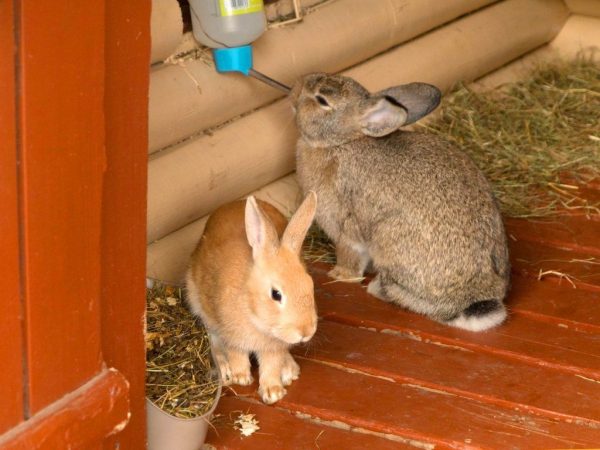Tips for building a rabbit farm
A rabbit farm is a very handy thing when keeping eared pets. Breeding them outside the rabbitry leads to the fact that the animals get sick more often, gain weight worse and die more often. Another problem is the constant fights between breeding males, who strive to sort things out.
- What is a mini rabbit farm
- Preparing for assembly
- The choice of materials for a rabbit farm
- Build start
- Creating a framework for a stand-alone rabbit farm
- Installation of walls and mother liquor
- Installation of floor and manure collection system
- System for removing manure from the premises
- Other equipment
- Feeders and drinkers
- Conclusion

Building a rabbit farm
You need a rabbit farm to keep the eared ears, and you can either buy it or make it yourself. For many farmers, doing it yourself is always a better option than buying it.
What is a mini rabbit farm
Some novice breeders do not know exactly what a mini rabbit farm is. But the rabbit farm is nothing more than a complex version of the classic rabbitry. However, it is more difficult to make it unlike an example because of the layout and design. A mini-farm for domestic rabbits is always made in such a way as to provide its inhabitants with a certain autonomy of keeping, and without complicating the design, this is impossible to achieve in principle.
A classic example of a rabbit farm is Mikhailov's designs, which are the basis for most of these schemes. There are many options for assembling such housing for eared pets, but they all have a similar layout due to the same requirements that the owners impose on them. Most often, mini-farms for rabbits are made in such a way that the owner has to devote as little time as possible to caring for the livestock, and not to the detriment of the animals.

Rabbit Mini Farm
If you have certain skills and tools, a mini-farm for rabbits is made with your own hands. For a beginner, it is sometimes recommended to practice assembling simpler versions of rabbitries, and then take on similar designs. There are a number of distinctive features that are common to all rabbit farms. These differences distinguish autonomous farms for domestic rabbits into a separate type of rabbitries.
This is the difference between a fully assembled, self-contained rabbit farm, built according to all the rules:
- In this building, there is always a well-thought-out system for removing droppings, and it works in automatic mode. The bunker should be emptied no more than once every 2-3 days, and in the most complex structures, removal occurs once a week.
- Additional heating system. In particular, the mother house for the rabbit and the drinker is heated. The very same mini-farm for breeding rabbits is made without cracks and with insulation. Without this, it will be too cold inside it in winter for comfortable maintenance.
- Sophisticated ventilation. Normal breeding of rabbits in such a dwelling is impossible without normal ventilation. In the event that the farm consists of several tiers, a separate ventilation system is made for each of them.
- A feeder and watering system capable of supplying animals without the intervention of the farmer. To begin with, the volumes of each trough and drinker should be large enough. At the same time, the water in the drinkers should not rot, and the food in the feeders should be varied and nutritious.
Another thing to think about in advance is the choice of materials for construction. Wood, the main building material, should be free of unnecessary cracks, chips and splinters. It is desirable to impregnate it with compounds from fungi and insects, but only with those that will not harm the inhabitants of the dwelling. You will also need high-quality metal for assembly, for example, sheets of galvanized iron. For windows and doors, a fine-mesh metal mesh is required. But glass and plastic are usually not used in the assembly.
Preparing for assembly
A rabbit farmer must first assess the profitability of building autonomous rabbit farms, because it is very difficult to make such a dwelling, and at the same time, the assembly must go right so that there are no gaps and other shortcomings in the structure. For a large farm that grows eared pets on an industrial scale, it is best to purchase ready-made cages. But for use on a personal backyard, it is better to assemble a rabbit farm with your own hands, if only because the price of materials will always be lower than the price of a finished farm.
Only those who decide to make it can estimate the cost of a mini-farm for rabbits. It all depends on the cost and availability of building materials in the area. The amount of materials can only be determined when the exact dimensions of the room are established. You can use ready-made drawings, although a person who is knowledgeable in engineering is able to draw them with his own hands, just by looking at the photo of the structure. Further, the rabbit farm is built according to a previously prepared plan.
So, standard farm sizes can vary, depending on what breed the owner will be growing. The larger the rabbits, the larger the farm will be for those rabbits. On average, this structure will have the following dimensions: the length is 2-2.5 m, the width is from 50 to 65 cm, and the height is 60-80 cm. And we are talking about the height of the front wall: the back is 10-15 cm lower , in order to get a roof slope. The farm itself is made at a height of 0.5-0.7 m above ground level.
The choice of materials for a rabbit farm
In most cases, the mini rabbit farm is made from wood. It can be installed on almost any garden plot. And small farms also prefer wooden dwellings for domestic rabbits. This material is both practical and reasonably cheap, which makes the farm for breeding domestic rabbits more profitable. And it doesn't matter for what purpose it is being built: to obtain rabbit skins or to sell rabbit carcasses.

Farmers prefer wooden dwellings for rabbits
For the frame, it is best to take strong beams, and wood or plywood is suitable for the walls. It is best to take both, since with year-round maintenance it is best to additionally insulate the room. If we talk about the materials that are used as insulation, then foam or felt is usually chosen here. Styrofoam can be taken from old packaging materials, and felt can be bought or ripped out of old shoes and clothes. The most difficult thing is to insulate the floors, since they must be of the slatted type.
Some owners use electric heated floors to insulate their rabbit dwellings. But, although such a measure seems more modern, it is not suitable for a mini rabbit farm.
If we talk about materials for the roof and manure bunker, then galvanized iron or other similar metal is best suited here. The bunker can be insulated from the outside so that cold does not penetrate into the room through it. The roof is usually insulated with roofing material, which is placed under the roofing iron.
Build start
So, first you need to decide what type of structure to install on the backyard. You can make it exclusively for summer maintenance, or you can make additional insulation based on winter. It should be noted right away that the price of a room designed for year-round breeding will be higher than that of the summer version.
When a rabbit farm is assembled with your own hands, you need to take into account not only financial possibilities. It is also worth deciding what exactly the farmer will be able to do on his own, without resorting to someone else's help.
At the stage when the design is underway, you should not focus on large rabbit farms. It is not at all easy to assemble autonomous industrial-type farms by hand; it requires knowledge and tools that not all rabbit breeders have.
If you build a rabbit farm from scratch, then it is better to take the drawings of I. N. Mikhailov as a basis and create your own project on their basis. The assembled mini-farms of this type can yield 35-40 heads of rabbits every year.
The best option is two-storey rabbit mini-farms for year-round keeping of animals. Two tiers are easy to maintain, and a certain amount of space is saved. It is of this type that many industrial structures are usually made. A number of farmers do not recommend buying such a rabbit farm. In order for the sale of a finished farm to be profitable, collectors give a considerable margin, therefore, in the Russian Federation, in the Republic of Belarus, and in Ukraine it is cheaper for rabbit breeders to assemble this structure on their own.
Creating a framework for a stand-alone rabbit farm
Work on the farm begins with the assembly of the frame for it, and, as already mentioned, it is made of strong wooden beams. Before starting work, it is recommended to sand the board and treat it with antifungal compounds. In order to successfully organize a farm for raising rabbits, it is imperative to follow the veterinary and sanitary rules for breeding these animals, so there should not be any chips or splinters on the bars that could harm the future inhabitants of the home.
Vertical beams for a one-story farm must be taken on the basis that its floor will be at a height of 0.5-0.7 m above the ground. In this case, the height of the front wall will be 15-20 cm higher than the height of the back wall. If you need to make 2 floors, then the distance between them should be 25-30 cm, so as not to make an overly high dwelling. A gap should remain in order to assemble a waste disposal system from the rabbitry. This system will be described in detail below.
In addition to the vertical beams for the frame, 8 more horizontal cuts of the beam will be required. Four will go in the length of the rabbitry, and four in width. It is from this calculation that their sizes must be made. How exactly the frame parts will be connected depends on the decision of the master. Examples of how assembly work can be done can be seen in the video. The creation scheme is relatively simple, and even a beginner in this business can figure it out. You just need to follow the basic recommendations and monitor the build quality.
Installation of walls and mother liquor
The walls and roof of the mini rabbit farm are made of tight-fitting boards. You can use a thin sheathing board, the so-called clapboard, but a floorboard is better. It is better not to use fiberboard or chipboard for a stand-alone farm due to their lower strength and durability. A roof is made of the same board, and this board is installed at an angle to provide a slope in case of precipitation. Well, to insulate the room from the inside, dense and high-quality plywood is used. The same material is needed when assembling a mother liquor for female rabbits.
Warming is done as follows. First you need to choose a suitable insulation. You should not use mineral wool or glass wool: rabbits are able to gnaw through walls, and then the insulation can harm them.It is better to take polystyrene or felt and lay it in a dense layer along the walls, and nail plywood on top, and the assembly must be done so that there are no sharp corners and nail heads anywhere. After that, the wall of the mother liquor is installed inside the room across the room.
The equipment of the mother liquor is a mandatory procedure, since without it it is impossible to start raising young animals. The floor of the mother liquor is made solid. The width of the compartment for a rabbit with babies is equal to the width of the mini-farm itself, and the length is 30-40 cm, sometimes even more. There should be no cracks in the mother liquor, and the floor must be additionally insulated in the same way as the walls. There should also be no windows in it, because rabbits are burrowing animals, they raise their offspring in burrows, so the mother plant should resemble a burrow.
Installation of floor and manure collection system
It is very important to make the correct floor arrangement, since the conditions in which the animals are kept depends on its design, because the amount of droppings in the room does not depend on how many heads live inside, but on how thoughtful the floor design and the manure removal system are. Some inexperienced rabbit breeders make continuous floors, and then the waste products of the rabbits begin to accumulate inside, so it is recommended to lay the slats at a distance of 10-15 mm from each other so that the legs do not fall through.
Through this peculiar lattice, the droppings fall down and are removed from the dwelling. Reiki must be treated with a composition that protects against moisture. It is only important to make sure that this composition does not harm the animals.
It is impossible to make slats from metal: in winter, the paws of rabbits will begin to freeze to it. Only in one part of the farm is the floor made solid: in the brood box for the rabbit. It is also recommended to cover the floors with clean and soft hay, which will play the role of bedding and insulation. But it needs to be changed periodically.
System for removing manure from the premises
There is a classic scheme, also invented by I. Mikhailov, and it allows you to easily and effortlessly remove manure from the room. A mine is made under the slatted floor to remove manure. It is executed in the form of an inverted pyramid, and the slope of the walls in it must be at least 30 ° from the horizontal plane. On these walls, manure slides down and enters the pipe, and from it into the waste tank. The entire structure is made of non-corrosive metal, and there should be no extra gaps in it.
If the mini-truss is of a two-story type, then the pipe from the upper tier can be led out along the back wall of the lower floor. And the discharge will be carried out into the same container. Subsequently, rabbit droppings can be used as a good fertilizer in the garden. Such equipment can be cleaned with plain water, and with a well-thought-out ventilation system, cleaning can be started no more than once a week, or even less often. Here is what experienced experienced rabbit breeders write about the need for such a system:
“When building an autonomous mini-farm, for example, according to Mikhailov's scheme, it is imperative to think over a system for removing manure. It is always done on the basis of a slatted slatted floor. Some newbies make solid floors, sometimes to install a newfangled heating system. But such a scheme is suitable for ordinary rabbitries, and not for mini-farms. The farm must have a sophisticated automatic manure removal system. Lattice floor, drain and waste tank - all of these must be equipped with every such structure. "
Other equipment
Doors and windows are closed with a fine mesh made of stainless steel. It is imperative to install latches on the doors outside so that the pets do not fall out of their home. Sometimes a separate door is installed for the mother liquor, and it is always made without windows. Moreover, this particular door will require additional insulation so that there are no drafts inside the mother liquor.All doors should be located slightly above the floor, and be equipped with a kind of sills.
It is also worth considering the ventilation system in the room. For this, 2 pipes are installed, the exit of one of them is located at a height of 10-15 cm above the floor. The second is fixed almost to the ceiling. Air enters the room through the first pipe, and it is located in the far corner from the mother liquor. The second pipe is made diagonally from the first, at the other end of the room. There should not be separate ventilation in the mother liquor so that the young do not suffer from hypothermia. Normal temperature for adult rabbits is 12-18 ° C.
Feeders and drinkers
Separately, it is worth talking about feeders and drinkers, because their health, the speed of weight gain and the quality of both the carcass and the skins depend on what and how the rabbits are fed.
Mini farms usually have 3 feed bins. One is for hay and grass, the second is for combined feed or mash, and the third is for root vegetables and other similar foods. The compound feed is usually poured from the large container into the container in place. The manger is made in the form of an inverted trapezoid, from which the animals get grass as needed. For root crops, a bunker is made with a wide gap at the bottom, through which the pets get to food.

Arrangement of a mini-farm
All three schemes are focused on feeding food no more than once every 2-3 days.
Drinking bowls are made according to the same principle as a feed trough: an inverted closed vessel with water and a saucer. In winter, the water must be heated.
Conclusion
It is not easy to assemble a mini-farm for rabbits, but the result with proper assembly is worth the effort, because there is only one farm, which occupies no more than 1.5 square meters. m of area, allows you to grow up to 40 heads per year. And these are skins and delicious meat.


